Potential Ecological Risk Assessment of Heavy Metals in Cultivated Land Based on Soil Geochemical Zoning: Yishui County, North China Case Study
Abstract
:1. Introduction
2. Materials and Methods
2.1. Study Area
2.2. Sampling and Analysis
2.3. Evaluation Method
2.3.1. Soil Geochemical Zoning
2.3.2. Principal Component Analysis and Its Test
2.3.3. Evaluation of Soil Environmental Quality
2.3.4. Geoaccumulation Index
2.3.5. Potential Ecological Risk Index
3. Results
3.1. Soil Geochemical Zoning
3.2. Content Characteristics of Heavy Metals
3.3. Evaluation Results
4. Discussion
4.1. Comprehensive Assessment of Potential Ecological Risks
4.2. Consistency of Evaluation Results
5. Conclusions
Author Contributions
Funding
Institutional Review Board Statement
Informed Consent Statement
Data Availability Statement
Acknowledgments
Conflicts of Interest
References
- Kheir, R.B.; Greve, M.H.; Abdallah, C.; Dalgaard, T. Spatial soil zinc content distribution from terrain parameters: A GIS-based decision-tree model in Lebanon. Environ. Pollut. 2010, 158, 520–528. [Google Scholar] [CrossRef]
- Dou, L.; Li, T. Regional Geochemical Characteristics and Influence Factors of Soil Elements in the Pearl River Delta Economic Zone, China. Int. J. Geosci. 2015, 6, 593–604. [Google Scholar] [CrossRef] [Green Version]
- García-Lorenzo, M.L.; Pérez-Sirvent, C.; Sánchez, M.J.M.; Ruiz, J.M.; Martínez, S.; Arroyo, X.; Martinez, L.B.M.; Bech, J.; Lopez, S.M. Potential bioavailability assessment and distribution of heavy metal(oids) in cores from Portman Bay (SE, Spain). Geochem. Explor. Environ. Anal. 2018, 19, 193–200. [Google Scholar] [CrossRef]
- Jennings, A.A. Analysis of worldwide regulatory guidance values for the most commonly regulated elemental surface soil contamination. J. Environ. Manag. 2013, 118, 72–95. [Google Scholar] [CrossRef]
- Ahmed, M.; Matsumoto, M.; Ozaki, A.; Thinh, N.; Kurosawa, K. Heavy Metal Contamination of Irrigation Water, Soil, and Vegetables and the Difference between Dry and Wet Seasons Near a Multi-Industry Zone in Bangladesh. Water 2019, 11, 583. [Google Scholar] [CrossRef] [Green Version]
- Ma, R.; Zhou, X.; Shi, J. Heavy metal contamination and health risk assessment in Critical Zone of Luan River Catchment in the North China Plain. Geochem. Explor. Environ. Anal. 2017, 18, 47–57. [Google Scholar] [CrossRef]
- Ok, Y.S.; Lim, J.E.; Moon, D.H. Stabilization of Pb and Cd contaminated soils and soil quality improvements using waste oyster shells. Environ. Geochem. Health 2010, 33, 83–91. [Google Scholar] [CrossRef] [PubMed]
- Parisa, P.; Samad, A.; Soroush, M.; David, C. Application of geochemistry and VNIR spectroscopy in mapping heavy metal pollution of stream sediments in the Takab mining area, NW of Iran. Acta. Geol. Sin. 2021, 92, 2382–2394. [Google Scholar] [CrossRef]
- Ren, S.; Li, E.; Deng, Q.; He, H.; Li, S. Analysis of the Impact of Rural Households’ Behaviors on Heavy Metal Pollution of Arable Soil: Taking Lankao County as an Example. Sustainability 2018, 10, 4368. [Google Scholar] [CrossRef] [Green Version]
- Sun, Y.; Zhou, Q.; Xie, X.; Liu, R. Spatial, sources and risk assessment of heavy metal contamination of urban soils in typical regions of Shenyang, China. J. Hazard. Mater. 2010, 174, 455–462. [Google Scholar] [CrossRef] [PubMed]
- Zhang, Q.; Wang, C. Natural and Human Factors Affect the Distribution of Soil Heavy Metal Pollution: A Review. Water Air Soil Pollut. 2020, 231, 350. [Google Scholar] [CrossRef]
- Jahan, I.; Abedin, M.A.; Islam, M.R.; Hossain, M.; Hoque, T.S.; Quadir, Q.F.; Hossain, M.I.; Gaber, A.; Althobaiti, Y.S.; Rahman, M.M. Translocation of Soil Arsenic towards Accumulation in Rice: Magnitude of Water Management to Minimize Health Risk. Water 2021, 13, 2816. [Google Scholar] [CrossRef]
- Kamiya, T.; Islam, R.; Duan, G.; Uraguchi, S.; Fujiwara, T. Phosphate deficiency signaling pathway is a target of arsenate and phosphate transporterOsPT1is involved in As accumulation in shoots of rice. Soil Sci. Plant Nutr. 2013, 59, 580–590. [Google Scholar] [CrossRef]
- Siddique, A.B.; Rahman, M.M.; Islam, R.; Mondal, D.; Naidu, R. Response of Iron and Cadmium on Yield and Yield Components of Rice and Translocation in Grain: Health Risk Estimation. Front. Environ. Sci. 2021, 9, 716770. [Google Scholar] [CrossRef]
- Gu, Q.; Yu, T.; Yang, Z.; Ji, J.; Hou, Q.; Wang, L.; Wei, X.; Zhang, Q. Prediction and risk assessment of five heavy metals in maize and peanut: A case study of Guangxi, China. Environ. Toxicol. Pharmacol. 2019, 70, 103199. [Google Scholar] [CrossRef]
- Hu, W.; Huang, B.; Shi, X.; Chen, W.; Zhao, Y.; Jiao, W. Accumulation and health risk of heavy metals in a plot-scale vegetable production system in a peri-urban vegetable farm near Nanjing, China. Ecotoxicol. Environ. Saf. 2013, 98, 303–309. [Google Scholar] [CrossRef]
- Li, K.; Peng, M.; Zhao, C.D.; Yang, K.; Zhou, Y.L.; Liu, F. Vicennial implementation of geochemical survey of land quality in China. Earth Sci. Front. 2019, 26, 128–158. [Google Scholar] [CrossRef]
- Baran, A.; Wieczorek, J.; Mazurek, R.; Urbański, K.; Klimkowicz-Pawlas, A. Potential ecological risk assessment and predicting zinc accumulation in soils. Environ. Geochem. Health 2018, 40, 435–450. [Google Scholar] [CrossRef] [PubMed] [Green Version]
- Guo, W.; Huo, S.; Xi, B.; Zhang, J.; Wu, F. Heavy metal contamination in sediments from typical lakes in the five geographic regions of China: Distribution, bioavailability, and risk. Ecol. Eng. 2015, 81, 243–255. [Google Scholar] [CrossRef]
- Kim, B.S.M.; Angeli, J.L.F.; Ferreira, P.A.L.; de Mahiques, M.M.; Figueira, R. Critical evaluation of different methods to calculate the Geoaccumulation Index for environmental studies: A new approach for Baixada Santista—Southeastern Brazil. Mar. Pollut. Bull. 2018, 127, 548–552. [Google Scholar] [CrossRef]
- Liu, X.; Jiang, J.; Yan, Y.; Dai, Y.; Deng, B.; Ding, S.; Su, S.; Sun, W.; Li, Z.; Gan, Z. Distribution and risk assessment of metals in water, sediments, and wild fish from Jinjiang River in Chengdu, China. Chemosphere 2018, 196, 45–52. [Google Scholar] [CrossRef]
- Kandawire, M.E.; Choongo, K.; Yabe, J.; Mwase, M.; Saasa, N.; Nakayama, S.M.M.; Bortey-Sam, N.; Blindauer, C.A. Sedi-ment metal contamination in the Kafue River of Zambia and ecological risk assessment. Bull. Environ. Contam. Toxicol. 2017, 99, 108–116. [Google Scholar] [CrossRef]
- Wang, G.; Zhang, Y.; Wang, J.; Zhu, L.; Wang, J. Spatial Distribution and Ecological Risk Assessment of Heavy Metals in Sediments of a Heavily Polluted Maozhou River, Southern China. Bull. Environ. Contam. Toxicol. 2021, 106, 844–851. [Google Scholar] [CrossRef] [PubMed]
- Zhao, H.; Zhao, J.; Yin, C.; Li, X. Index models to evaluate the potential metal pollution contribution from washoff of road-deposited sediment. Water Res. 2014, 59, 71–79. [Google Scholar] [CrossRef] [PubMed]
- Chen, Y.; Jiang, X.; Wang, Y.; Zhuang, D. Spatial characteristics of heavy metal pollution and the potential ecological risk of a typical mining area: A case study in China. Process. Saf. Environ. Prot. 2018, 113, 204–219. [Google Scholar] [CrossRef]
- Guo, G.; Wu, F.; Xie, F.; Zhang, R. Spatial distribution and pollution assessment of heavy metals in urban soils from southwest China. J. Environ. Sci. 2012, 24, 410–418. [Google Scholar] [CrossRef]
- Jiang, X.; Lu, W.X.; Zhao, H.Q.; Yang, Q.C.; Yang, Z.P. Potential ecological risk assessment and prediction of soil heavy-metal pollution around coal gangue dump. Nat. Hazards Earth Syst. Sci. 2014, 14, 1599–1610. [Google Scholar] [CrossRef] [Green Version]
- Laidlaw, M.A.; Mohmmad, S.M.; Gulson, B.L.; Taylor, M.P.; Kristensen, L.J.; Birch, G. Estimates of potential childhood lead exposure from contaminated soil using the US EPA IEUBK Model in Sydney, Australia. Environ. Res. 2017, 156, 781–790. [Google Scholar] [CrossRef]
- Nicholson, F.A.; Smith, S.R.; Alloway, B.J.; Carlton-Smith, C.; Chambers, B.J. An inventory of heavy metals inputs to agricultural soils in England and Wales. Sci. Total Environ. 2003, 311, 205–219. [Google Scholar] [CrossRef]
- Sheng, D.; Wu, J.; Wen, X.; Wu, M.; Zhang, C. Contamination and ecological health risks of heavy metals in groundwater of a typical agricultural area in NW China. Geochem. Explor. Environ. Anal. 2020, 20, 440–450. [Google Scholar] [CrossRef]
- Yang, C.L.; Guo, R.P.; Yue, Q.L.; Zhou, K.; Wu, Z.F. Environmental quality assessment and spatial pattern of potentially toxic elements in soils of Guangdong Province, China. Environ. Earth Sci. 2013, 70, 1903–1910. [Google Scholar] [CrossRef]
- Yin, S.; Feng, C.; Li, Y.; Yin, L.; Shen, Z. Heavy metal pollution in the surface water of the Yangtze Estuary: A 5-year follow-up study. Chemosphere 2015, 138, 718–725. [Google Scholar] [CrossRef] [PubMed]
- Müller, G. Schwermetalle in den sedimenten des Rheins—Veranderungen seit 1971. Umschau 1979, 79, 778–783. [Google Scholar]
- Sany, S.B.T.; Salleh, A.; Rezayi, M.; Saadati, N.; Narimany, L.; Tehrani, G.M. Distribution and Contamination of Heavy Metal in the Coastal Sediments of Port Klang, Selangor, Malaysia. Water Air Soil Pollut. 2013, 224, 224. [Google Scholar] [CrossRef]
- Nobi, E.; Dilipan, E.; Thangaradjou, T.; Sivakumar, K.; Kannan, L. Geochemical and geo-statistical assessment of heavy metal concentration in the sediments of different coastal ecosystems of Andaman Islands, India. Estuar. Coast. Shelf Sci. 2010, 87, 253–264. [Google Scholar] [CrossRef]
- de Vallejuelo, S.F.-O.; Arana, G.; de Diego, A.; Madariaga, J.M. Risk assessment of trace elements in sediments: The case of the estuary of the Nerbioi–Ibaizabal River (Basque Country). J. Hazard. Mater. 2010, 181, 565–573. [Google Scholar] [CrossRef]
- Zahra, A.; Hashmi, M.Z.; Malik, R.N.; Ahmed, Z. Enrichment and geo-accumulation of heavy metals and risk assessment of sediments of the Kurang Nallah—Feeding tributary of the Rawal Lake Reservoir, Pakistan. Sci. Total Environ. 2014, 470–471, 925–933. [Google Scholar] [CrossRef] [PubMed]
- Alahabadi, A.; Malvandi, H. Contamination and ecological risk assessment of heavy metals and metalloids in surface sediments of the Tajan River, Iran. Mar. Pollut. Bull. 2018, 133, 741–749. [Google Scholar] [CrossRef]
- Håkanson, L. An ecological risk index for aquatic pollution control: A sedimentological approach. Water Res. 1980, 14, 975–1001. [Google Scholar] [CrossRef]
- Cheng, F.; Wang, H.B.; Yun, W.J. Study on investigation and assessment of cultivated land quality grade in China. China Land Sci. 2014, 28, 75–82. [Google Scholar] [CrossRef]
- Liu, L.; Zhou, D.; Chang, X.; Lin, Z. A new grading system for evaluating China’s cultivated land quality. Land Degrad. Dev. 2020, 31, 1482–1501. [Google Scholar] [CrossRef]
- Huo, Z.; Tian, J.; Wu, Y.; Ma, F. A Soil Environmental Quality Assessment Model Based on Data Fusion and Its Application in Hebei Province. Sustainability 2020, 12, 6804. [Google Scholar] [CrossRef]
- Yang, Z.; Yu, T.; Hou, Q.; Xia, X.; Feng, H.; Huang, C.; Wang, L.; Lv, Y.; Zhang, M. Geochemical evaluation of land quality in China and its applications. J. Geochem. Explor. 2014, 139, 122–135. [Google Scholar] [CrossRef]
- Xi, X.H. Ecological geochemistry: From a geochemical survey to an applied theory. Earth Sci. Front. 2008, 15, 1–8. [Google Scholar] [CrossRef]
- Liao, Q.L.; Liu, C.; Jin, Y.; Hua, M.; Zheng, L.C.; Pan, Y.M.; Huang, S.S. On geochemical regionalization of soils in Jiangsu, China. J. Geol. 2011, 35, 225–235. [Google Scholar]
- Facchinelli, A.; Sacchi, E.; Mallen, L. Multivariate statistical and GIS-based approach to identify heavy metal sources in soils. Environ. Pollut. 2001, 114, 313–324. [Google Scholar] [CrossRef]
- Gergen, I.; Harmanescu, M. Application of principal component analysis in the pollution assessment with heavy metals of vegetable food chain in the old mining areas. Chem. Central J. 2012, 6, 156. [Google Scholar] [CrossRef] [Green Version]
- Han, L.; Li, Y. Distributions, Source and Pollution Status of Heavy Metals of Urban Soil in Xining, China. IOP Conf. Ser. Earth Environ. Sci. 2020, 555, 012084. [Google Scholar] [CrossRef]
- Pang, X.G.; Wang, Z.H.; Zhao, X.Q.; Zeng, X.D.; Ren, W.J.; Dai, J.R. Background values of soil geochemistry in Shandong Province. Shandong Land Resour. 2018, 34, 39–43. [Google Scholar] [CrossRef]
- Tian, K.; Huang, B.; Xing, Z.; Hu, W. Geochemical baseline establishment and ecological risk evaluation of heavy metals in greenhouse soils from Dongtai, China. Ecol. Indic. 2017, 72, 510–520. [Google Scholar] [CrossRef]
- Sposito, G. The Surface Chemistry of Soil; Oxford University Press: New York, NY, USA, 1984. [Google Scholar]
- Yan, M.C.; Gu, T.X.; Chi, Q.H.; Wang, C. Abundance of chemical elements of soils in China and supergenesis geochemistry characteristics. Geophys. Geochem. Explor. 1997, 21, 161–167. [Google Scholar]
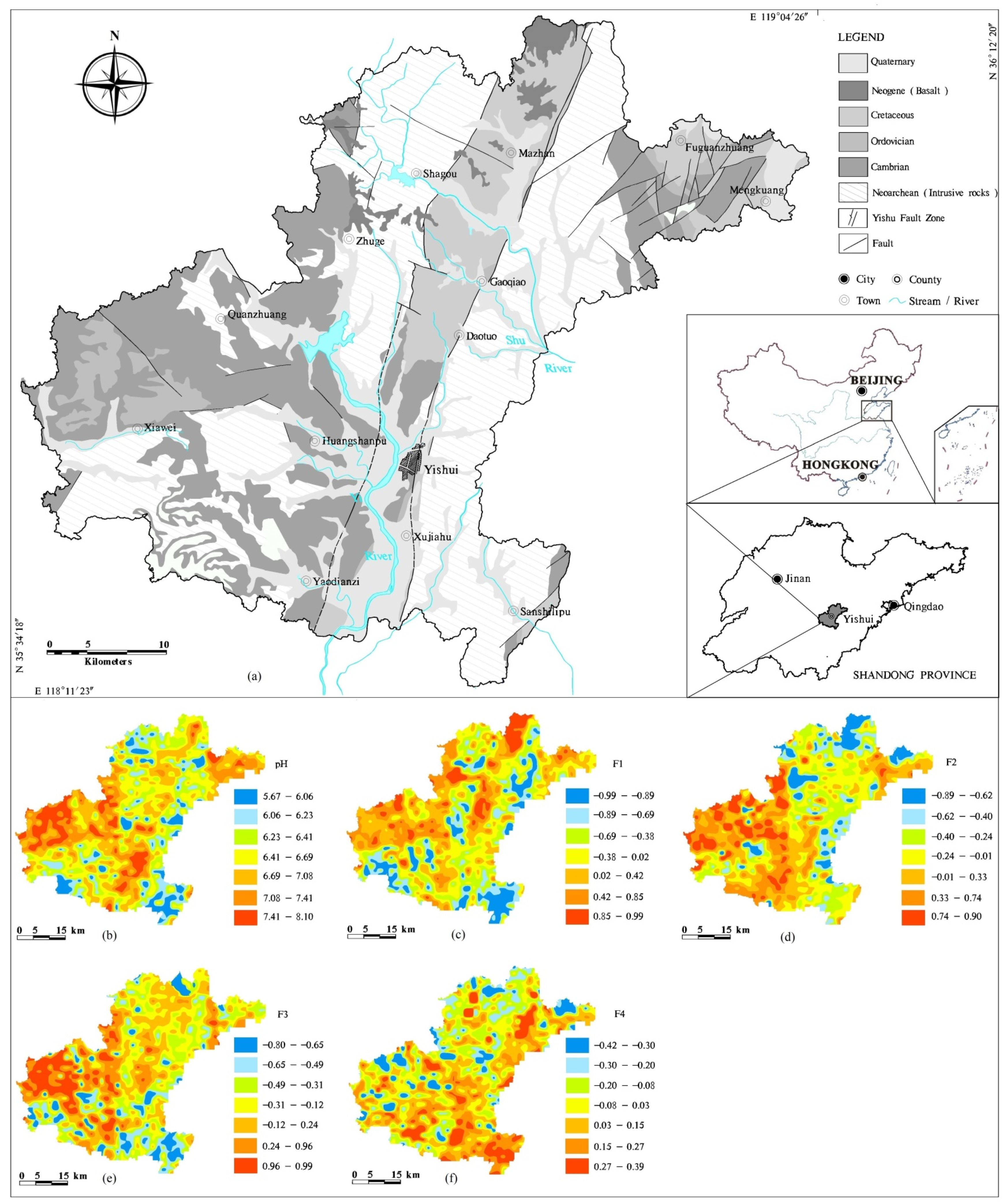
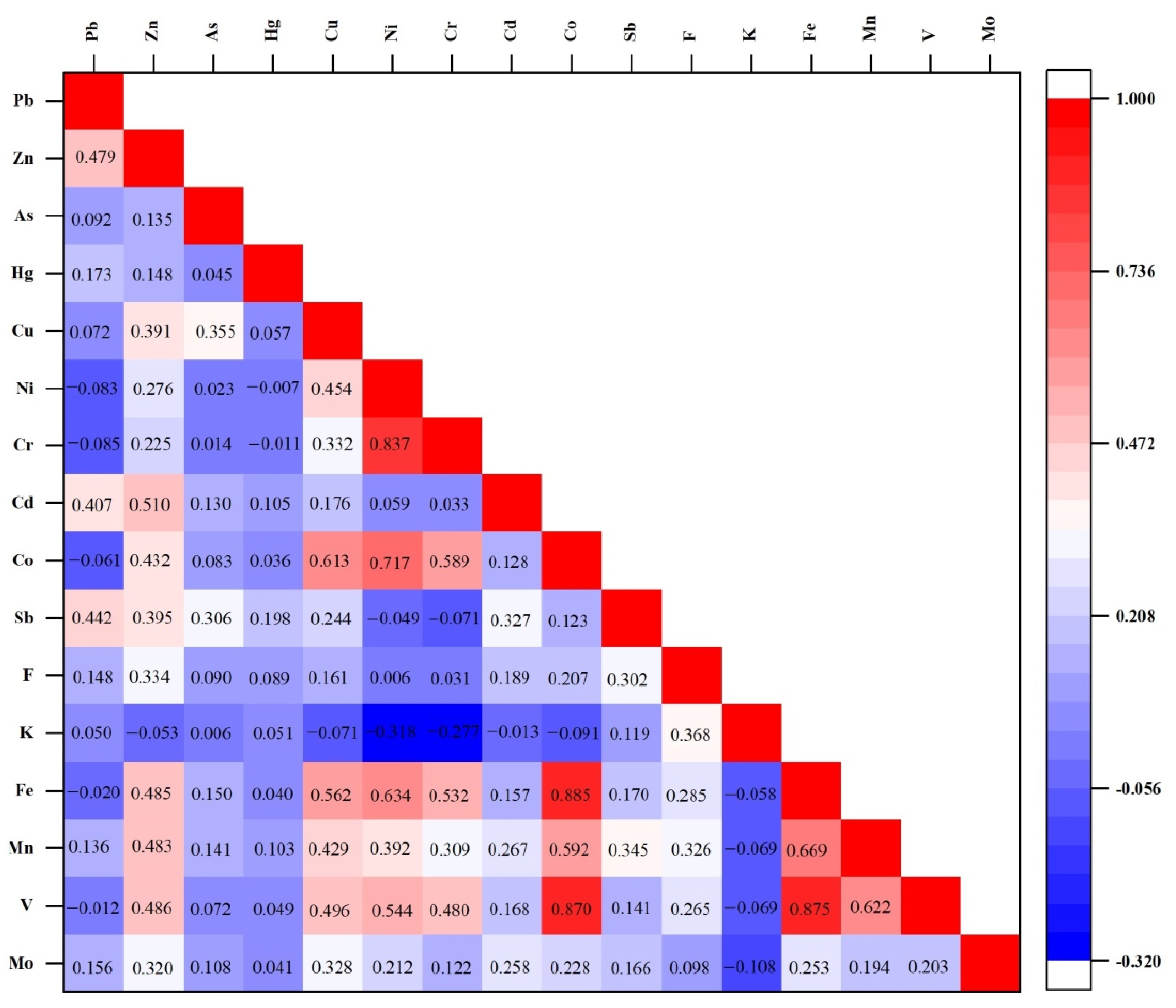
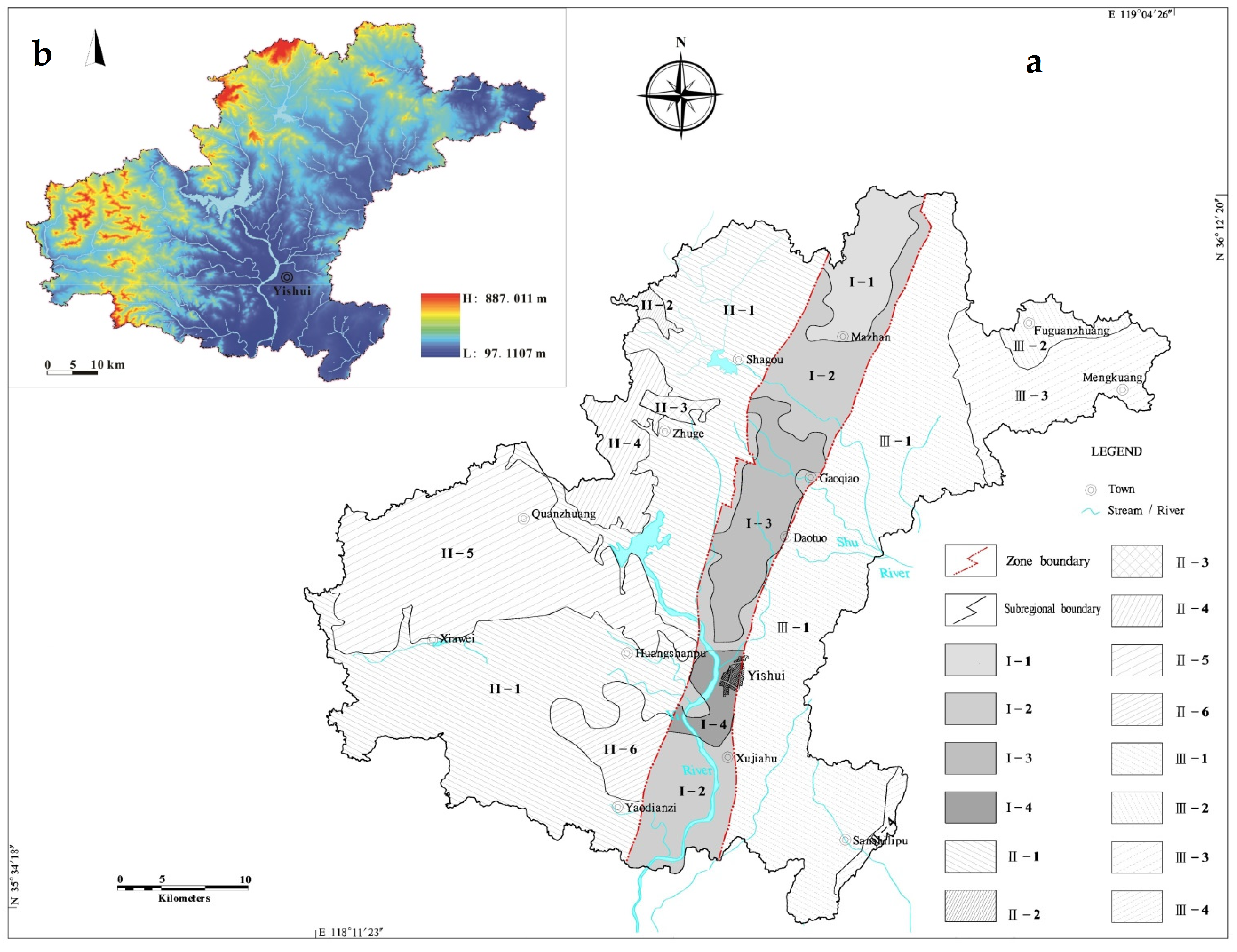
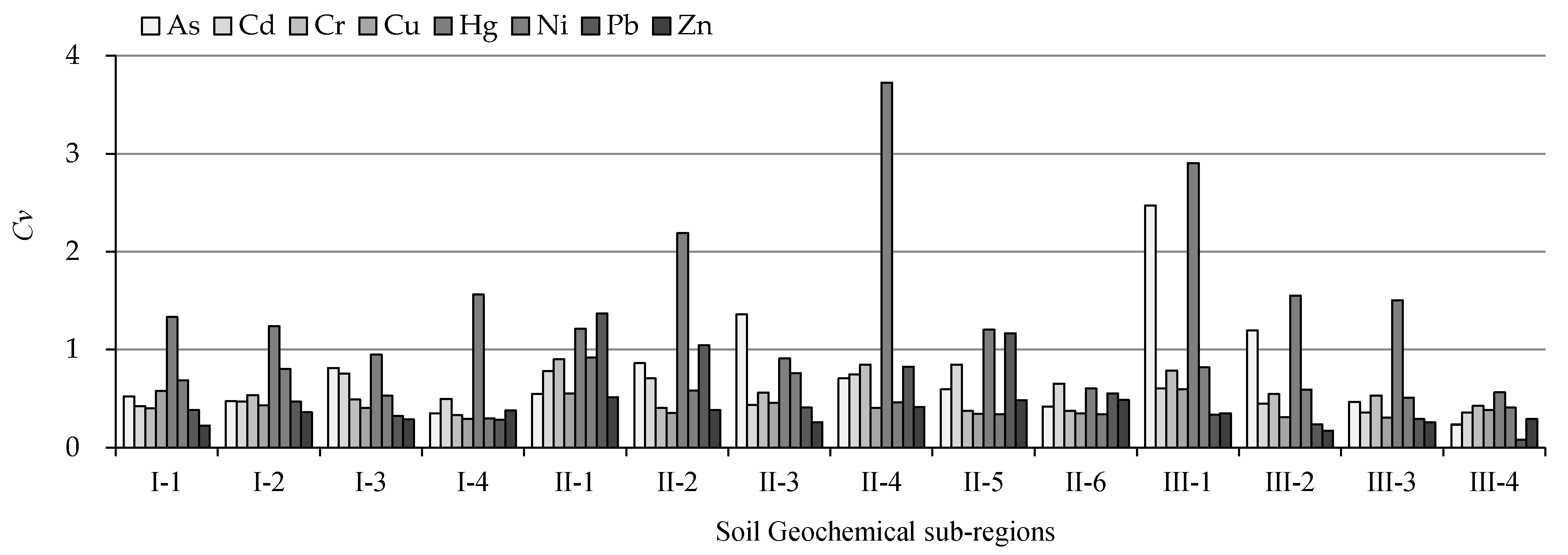
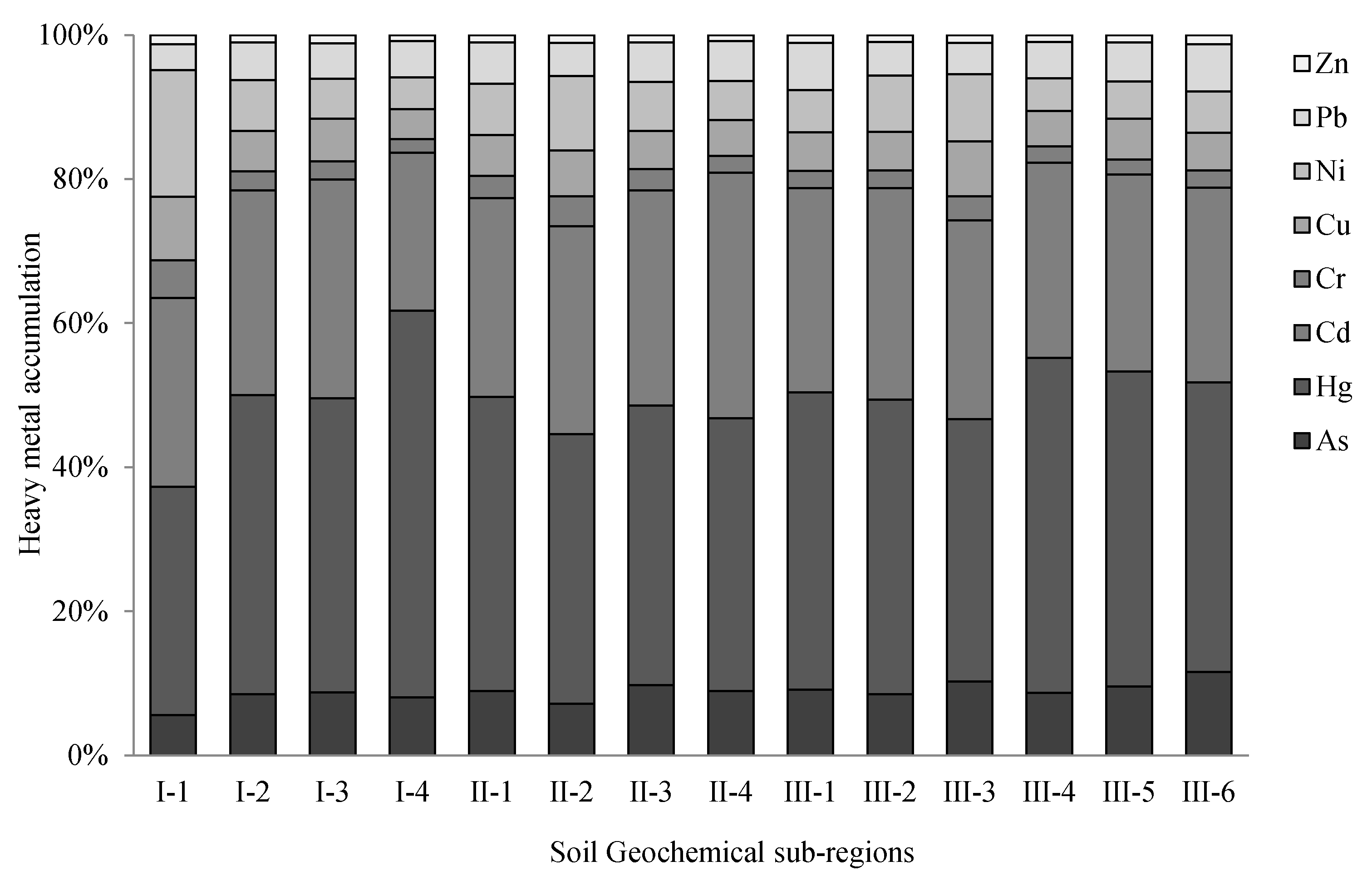
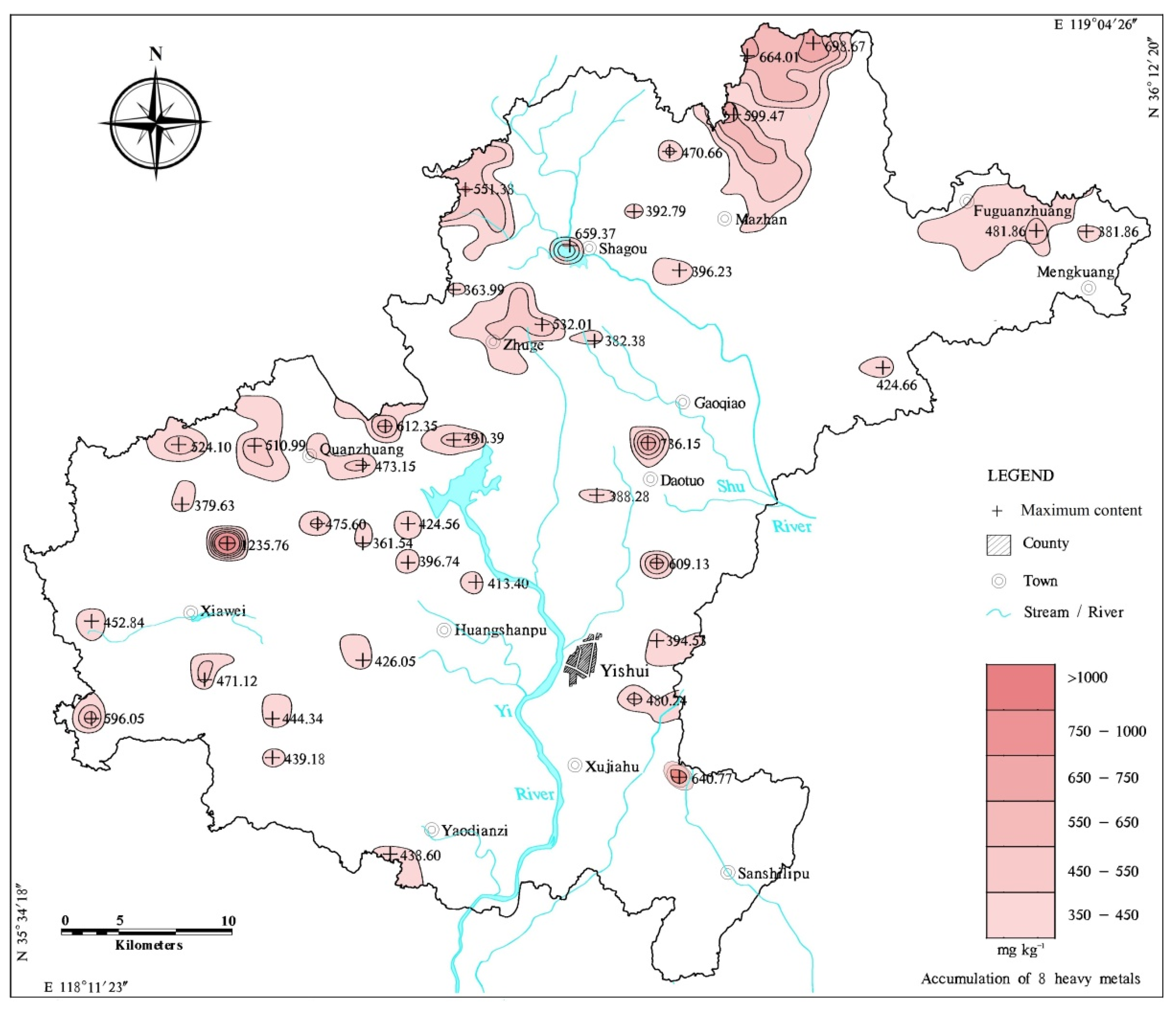
| Value | Class | Pollution Level |
|---|---|---|
| PN ≤ 0.7 | I | Unpolluted |
| 0.7 < PN ≤ 1.0 | II | Warning line of pollution |
| 1.0 < PN ≤ 2.0 | III | Low level polluted |
| 2.0 < PN ≤ 3.0 | IV | Moderately polluted |
| PN > 3.0 | V | High level polluted |
| Value | Class | Quality of Soil |
|---|---|---|
| Igeo ≤ 0 | I | Unpolluted |
| 0 < Igeo ≤ 1 | II | From unpolluted to moderately polluted |
| 1 < Igeo ≤ 2 | III | Moderately polluted |
| 2 < Igeo ≤ 3 | IV | From moderately to strongly polluted |
| 3 < Igeo ≤ 4 | V | Strongly polluted |
| 4 < Igeo ≤ 5 | VI | From strongly to extremely polluted |
| Igeo > 5 | VII | Extremely polluted |
| Potential Risk Factor | Single Factor Pollution Ecological Risk | Potential Ecological Risk Index | Risk Intensity |
|---|---|---|---|
| Eir < 40 | Low | RI < 150 | Low |
| 40 ≤ Eir < 80 | Moderate | 150 ≤ RI < 300 | Moderate |
| 80 ≤ Eir < 160 | High | 300 ≤ RI < 600 | High |
| 160 ≤ Eir < 320 | Slightly heavy | RI ≥ 600 | heavy |
| Eir ≥ 320 | Heavy |
| Component | Eigenvalue | Variance Contribution Rate/% | Cumulative Variance Contribution Rate/% | Structural Formula of Principal Component Factors |
|---|---|---|---|---|
| F1 | 5.3 | 33.3 | 33.3 | Fe0.898 Co0.888 V0.853 Mn0.745 Ni0.719 Cu0.698 Zn0.666 Cr0.624 (Mo0.386) |
| F2 | 2.5 | 15.8 | 49.1 | Pb0.684 Sb0.668 Cd0.536 (Hg0.294) |
| F3 | 1.4 | 8.8 | 57.9 | K2O0.722 F0.564 |
| F4 | 1.1 | 7.0 | 64.9 | As0.825 |
| Element | Component | Element | Component | ||||||
|---|---|---|---|---|---|---|---|---|---|
| F1 | F2 | F3 | F4 | F1 | F2 | F3 | F4 | ||
| Fe | 0.898 | −0.168 | 0.204 | −0.004 | Mo | 0.386 | 0.179 | −0.340 | 0.117 |
| Co | 0.888 | −0.270 | 0.159 | −0.016 | Pb | 0.166 | 0.684 | −0.341 | −0.235 |
| V | 0.853 | −0.160 | 0.216 | −0.096 | Sb | 0.329 | 0.668 | −0.012 | 0.174 |
| Mn | 0.745 | 0.126 | 0.139 | −0.056 | Cd | 0.348 | 0.536 | −0.323 | −0.201 |
| Ni | 0.719 | −0.488 | −0.191 | −0.069 | Hg | 0.114 | 0.294 | −0.027 | −0.144 |
| Cu | 0.698 | 0.018 | −0.032 | 0.422 | K2O | −0.137 | 0.367 | 0.722 | −0.020 |
| Zn | 0.666 | 0.449 | −0.181 | −0.229 | F | 0.342 | 0.418 | 0.564 | −0.129 |
| Cr | 0.624 | −0.487 | −0.167 | −0.118 | As | 0.226 | 0.273 | −0.059 | 0.825 |
| The Soil Geochemical Subregion (N Represents the Number of Samples) | wt/mg kg−1 | |||||||
|---|---|---|---|---|---|---|---|---|
| As | Cd | Cr | Cu | Hg | Ni | Pb | Zn | |
| I-1 (N = 447) | 5.27 | 0.126 | 177.65 | 43.34 | 0.0268 | 104.20 | 18.67 | 86.62 |
| I-2 (N = 1299) | 7.64 | 0.131 | 85.74 | 26.48 | 0.0336 | 39.84 | 25.86 | 68.57 |
| I-3 (N = 589) | 7.45 | 0.133 | 77.45 | 26.47 | 0.0314 | 29.81 | 23.20 | 71.00 |
| I-4 (N = 156) | 8.09 | 0.113 | 68.17 | 22.04 | 0.0485 | 27.89 | 27.57 | 63.64 |
| II-1 (N = 2102) | 7.79 | 0.124 | 74.10 | 24.12 | 0.0319 | 31.74 | 30.78 | 69.65 |
| II-2 (N = 52) | 12.04 | 0.214 | 125.72 | 39.87 | 0.0524 | 70.09 | 36.31 | 103.43 |
| II-3 (N = 73) | 10.19 | 0.140 | 117.62 | 39.90 | 0.0326 | 58.32 | 23.64 | 79.88 |
| II-4 (N = 467) | 10.24 | 0.163 | 95.18 | 30.41 | 0.0492 | 33.65 | 32.77 | 83.07 |
| II-5 (N = 1923) | 10.26 | 0.150 | 80.83 | 32.12 | 0.0423 | 35.10 | 31.70 | 82.06 |
| II-6 (N = 359) | 9.58 | 0.114 | 71.52 | 22.67 | 0.0299 | 30.08 | 29.69 | 76.94 |
| III-1 (N = 3142) | 6.95 | 0.110 | 87.00 | 23.26 | 0.0286 | 34.82 | 24.51 | 59.22 |
| III-2 (N = 211) | 6.46 | 0.133 | 135.34 | 30.15 | 0.0306 | 59.12 | 22.75 | 72.24 |
| III-3 (N = 794) | 8.70 | 0.137 | 94.94 | 25.11 | 0.0313 | 38.33 | 26.94 | 67.45 |
| III-4 (N = 89) | 6.15 | 0.120 | 57.92 | 17.81 | 0.0235 | 23.62 | 21.04 | 41.54 |
| Average value of Yishui County (N = 14,389) | 7.85 | 0.129 | 88.30 | 27.05 | 0.0323 | 38.25 | 27.41 | 69.80 |
| Geochemical background value of topsoil in Shandong Province [49] | 8.60 | 0.132 | 62.00 | 22.60 | 0.0310 | 27.10 | 23.60 | 63.30 |
| Topsoils in China (Am) [52] | 11.20 | 0.097 | 61.00 | 23.00 | 0.0650 | 27.00 | 26.00 | 74 |
| Pollution risk screening value of agricultural land (GB15618-2018 1) | 25 | 0.3 | 150 | 50 | 0.5 | 70 | 90 | 200 |
| The Soil Geochemical Subregion (N Represents the Number of Samples) | Pi | PN | |||||||
|---|---|---|---|---|---|---|---|---|---|
| As | Cd | Cr | Cu | Hg | Ni | Pb | Zn | ||
| I-1 (N = 447) | 0.21 | 0.42 | 1.18 | 0.87 | 0.05 | 1.49 | 0.21 | 0.43 | 1.14 |
| I-2 (N = 1299) | 0.31 | 0.44 | 0.57 | 0.53 | 0.07 | 0.57 | 0.29 | 0.34 | 0.49 |
| I-3 (N = 589) | 0.30 | 0.44 | 0.52 | 0.53 | 0.06 | 0.43 | 0.26 | 0.35 | 0.45 |
| I-4 (N = 156) | 0.32 | 0.38 | 0.45 | 0.44 | 0.10 | 0.40 | 0.31 | 0.32 | 0.40 |
| II-1 (N = 2102) | 0.31 | 0.41 | 0.49 | 0.48 | 0.06 | 0.45 | 0.34 | 0.35 | 0.43 |
| II-2 (N = 52) | 0.48 | 0.71 | 0.84 | 0.80 | 0.10 | 1.00 | 0.40 | 0.52 | 0.83 |
| II-3 (N = 73) | 0.41 | 0.47 | 0.78 | 0.80 | 0.07 | 0.83 | 0.26 | 0.40 | 0.69 |
| II-4 (N = 467) | 0.41 | 0.54 | 0.63 | 0.61 | 0.10 | 0.48 | 0.36 | 0.42 | 0.55 |
| II-5 (N = 1923) | 0.41 | 0.50 | 0.54 | 0.64 | 0.08 | 0.50 | 0.35 | 0.41 | 0.55 |
| II-6 (N = 359) | 0.38 | 0.38 | 0.48 | 0.45 | 0.06 | 0.43 | 0.33 | 0.38 | 0.42 |
| III-1 (N = 3142) | 0.28 | 0.37 | 0.58 | 0.47 | 0.06 | 0.50 | 0.27 | 0.30 | 0.48 |
| III-2 (N = 211) | 0.26 | 0.44 | 0.90 | 0.60 | 0.06 | 0.84 | 0.25 | 0.36 | 0.72 |
| III-3 (N = 794) | 0.35 | 0.46 | 0.63 | 0.50 | 0.06 | 0.55 | 0.30 | 0.34 | 0.53 |
| III-4 (N = 89) | 0.25 | 0.40 | 0.39 | 0.36 | 0.05 | 0.34 | 0.23 | 0.21 | 0.34 |
| The Soil Geochemical Sub-Region (N Represents the Number of Samples) | Igeo | |||||||
|---|---|---|---|---|---|---|---|---|
| As | Cd | Cr | Cu | Hg | Ni | Pb | Zn | |
| I-1 (N = 447) | −1.29 | −0.66 | 0.93 | 0.35 | −0.79 | 1.36 | −0.92 | −0.13 |
| I-2 (N = 1299) | −0.76 | −0.60 | −0.12 | −0.36 | −0.47 | −0.029 | −0.45 | −0.47 |
| I-3 (N = 589) | −0.79 | −0.58 | −0.26 | −0.36 | −0.57 | −0.45 | −0.61 | −0.42 |
| I-4 (N = 156) | −0.67 | −0.81 | −0.45 | −0.62 | 0.062 | −0.54 | −0.36 | −0.58 |
| II-1 (N = 2102) | −0.73 | −0.67 | −0.33 | −0.49 | −0.54 | −0.36 | −0.20 | −0.45 |
| II-2 (N = 52) | −0.10 | 0.11 | 0.44 | 0.23 | 0.17 | 0.79 | 0.037 | 0.12 |
| II-3 (N = 73) | −0.34 | −0.50 | 0.34 | 0.24 | −0.51 | 0.52 | −0.58 | −0.25 |
| II-4 (N = 467) | −0.33 | −0.28 | 0.033 | −0.16 | 0.082 | −0.27 | −0.11 | −0.19 |
| II-5 (N = 1923) | −0.33 | −0.40 | −0.20 | −0.078 | −0.14 | −0.21 | −0.16 | −0.21 |
| II-6 (N = 359) | −0.43 | −0.79 | −0.38 | −0.58 | −0.64 | −0.43 | −0.25 | −0.30 |
| III-1 (N = 3142) | −0.89 | −0.85 | −0.10 | −0.54 | −0.70 | −0.22 | −0.53 | −0.68 |
| III-2 (N = 211) | −0.99 | −0.57 | 0.54 | −0.17 | −0.61 | 0.54 | −0.64 | −0.39 |
| III-3 (N = 794) | −0.57 | −0.53 | 0.030 | −0.43 | −0.57 | −0.085 | −0.39 | −0.49 |
| III-4 (N = 89) | −1.07 | −0.72 | −0.68 | −0.93 | −0.99 | −0.78 | −0.75 | −1.19 |
| Potential Ecological Risk Index | Eir | RI | ||||||||
|---|---|---|---|---|---|---|---|---|---|---|
| The Soil Geochemical Subregion | As | Hg | Cd | Cr | Cu | Ni | Pb | Zn | ||
| I-1 (N = 447) | 6.12 | 34.60 | 28.57 | 5.73 | 9.59 | 19.23 | 3.96 | 1.37 | 109.16 | |
| I-2 (N = 1299) | 8.89 | 43.35 | 29.68 | 2.77 | 5.86 | 7.35 | 5.48 | 1.08 | 104.45 | |
| I-3 (N = 589) | 8.66 | 40.57 | 30.11 | 2.50 | 5.86 | 5.50 | 4.92 | 1.12 | 99.23 | |
| I-4 (N = 156) | 9.40 | 62.62 | 25.59 | 2.20 | 4.88 | 5.15 | 5.84 | 1.01 | 116.69 | |
| II-1 (N = 2102) | 9.06 | 41.17 | 28.23 | 2.39 | 5.34 | 5.86 | 6.52 | 1.10 | 99.66 | |
| II-2 (N = 52) | 14.01 | 67.64 | 48.52 | 4.06 | 8.82 | 12.93 | 7.69 | 1.63 | 165.30 | |
| II-3 (N = 73) | 11.85 | 42.00 | 31.82 | 3.79 | 8.83 | 10.76 | 5.01 | 1.26 | 115.33 | |
| II-4 (N = 467) | 11.91 | 63.51 | 37.09 | 3.07 | 6.73 | 6.21 | 6.94 | 1.31 | 136.77 | |
| II-5 (N = 1923) | 11.93 | 54.54 | 34.05 | 2.61 | 7.11 | 6.48 | 6.72 | 1.30 | 124.71 | |
| II-6 (N = 359) | 11.14 | 38.56 | 26.00 | 2.31 | 5.02 | 5.55 | 6.29 | 1.22 | 96.08 | |
| III-1 (N = 3142) | 8.09 | 36.88 | 24.93 | 2.81 | 5.15 | 6.42 | 5.19 | 0.94 | 90.40 | |
| III-2 (N = 211) | 7.52 | 39.42 | 30.32 | 4.37 | 6.67 | 10.91 | 4.82 | 1.14 | 105.17 | |
| III-3 (N = 794) | 10.12 | 40.44 | 31.09 | 3.06 | 5.56 | 7.07 | 5.71 | 1.07 | 104.16 | |
| III-4 (N = 89) | 7.16 | 30.29 | 27.30 | 1.87 | 3.94 | 4.36 | 4.46 | 0.656 | 80.03 | |
| Evaluation Method | Nemerow Pollution Index | Geoaccumulation Index | Potential Ecological Risk Assessment | ||||||||||||
|---|---|---|---|---|---|---|---|---|---|---|---|---|---|---|---|
| The Soil Geochemical Subregion | PN | Pollution Level | Heavy Metal | Sequence | Igeo | Quality of Sediment | Heavy Metal | Sequence | Eri of Hg | Single Factor Pollution Ecological Risk | RI | Risk Intensity | Heavy Metal | Sequence | |
| I-1 | 1.14 | low level polluted | Ni Cr Cu | 1 | 1.36 | moderately polluted | Ni (Cr Cu) | 1 | 34.60 | low | 109.16 | low | Hg Cd Ni | 6 | |
| I-2 | 0.49 | unpolluted | <0 | unpolluted | 43.35 | moderate | 104.45 | low | Hg Cd | 8 | |||||
| I-3 | 0.45 | unpolluted | <0 | unpolluted | 40.57 | moderate | 99.23 | low | Hg Cd | 11 | |||||
| I-4 | 0.40 | unpolluted | <0 | unpolluted | 62.62 | moderate | 116.68 | low | Hg Cd | 4 | |||||
| II-1 | 0.43 | unpolluted | <0 | unpolluted | 41.17 | moderate | 99.66 | low | Hg Cd | 10 | |||||
| II-2 | 0.83 | warning line of pollution | Ni Cr Cu Cd | 2 | 0.786 | from unpolluted to moderately polluted | Ni (Cd Cr Cu Hg Pb Zn) | 2 | 67.64 | moderate | 165.30 | moderate | Hg Cd As Ni | 1 | |
| II-3 | 0.69 | unpolluted | Ni Cr Cu | 4 | 0.521 | from unpolluted to moderately polluted | Ni (Cr Cu) | 4 | 42.00 | moderate | 115.33 | low | Hg Cd As Ni | 5 | |
| II-4 | 0.55 | unpolluted | 5 | 0.033 | from unpolluted to moderately polluted | Hg (Cr) | 5 | 63.51 | moderate | 136.77 | low | Hg Cd As | 2 | ||
| II-5 | 0.55 | unpolluted | 5 | <0 | unpolluted | 54.54 | moderate | 124.71 | low | Hg Cd As | 3 | ||||
| II-6 | 0.42 | unpolluted | <0 | unpolluted | 38.56 | low | 96.08 | low | Hg Cd As | 12 | |||||
| III-1 | 0.45 | unpolluted | <0 | unpolluted | 36.88 | low | 90.40 | low | Hg Cd | 13 | |||||
| III-2 | 0.72 | warning line of pollution | Cr Ni | 3 | 0.541 | from unpolluted to moderately polluted | Cr (Ni) | 3 | 39.42 | low | 105.16 | low | Hg Cd Ni | 7 | |
| III-3 | 0.53 | unpolluted | 6 | 0.030 | from unpolluted to moderately polluted | Cr | 6 | 40.44 | moderate | 104.12 | low | Hg Cd As | 9 | ||
| III-4 | 0.34 | unpolluted | <0 | unpolluted | 30.29 | low | 80.03 | low | Hg Cd | 14 | |||||
Publisher’s Note: MDPI stays neutral with regard to jurisdictional claims in published maps and institutional affiliations. |
© 2021 by the authors. Licensee MDPI, Basel, Switzerland. This article is an open access article distributed under the terms and conditions of the Creative Commons Attribution (CC BY) license (https://creativecommons.org/licenses/by/4.0/).
Share and Cite
Yu, L.; Zhang, F.; Zang, K.; He, L.; Wan, F.; Liu, H.; Zhang, X.; Shi, Z. Potential Ecological Risk Assessment of Heavy Metals in Cultivated Land Based on Soil Geochemical Zoning: Yishui County, North China Case Study. Water 2021, 13, 3322. https://doi.org/10.3390/w13233322
Yu L, Zhang F, Zang K, He L, Wan F, Liu H, Zhang X, Shi Z. Potential Ecological Risk Assessment of Heavy Metals in Cultivated Land Based on Soil Geochemical Zoning: Yishui County, North China Case Study. Water. 2021; 13(23):3322. https://doi.org/10.3390/w13233322
Chicago/Turabian StyleYu, Linsong, Fugui Zhang, Kai Zang, Ling He, Fang Wan, Hongbo Liu, Xiuwen Zhang, and Zeming Shi. 2021. "Potential Ecological Risk Assessment of Heavy Metals in Cultivated Land Based on Soil Geochemical Zoning: Yishui County, North China Case Study" Water 13, no. 23: 3322. https://doi.org/10.3390/w13233322
APA StyleYu, L., Zhang, F., Zang, K., He, L., Wan, F., Liu, H., Zhang, X., & Shi, Z. (2021). Potential Ecological Risk Assessment of Heavy Metals in Cultivated Land Based on Soil Geochemical Zoning: Yishui County, North China Case Study. Water, 13(23), 3322. https://doi.org/10.3390/w13233322







